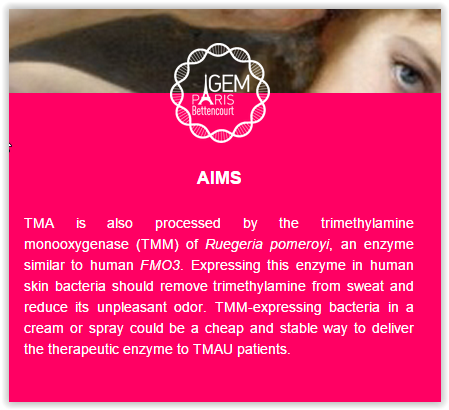 |
| Click to visit link |
Link : Something Fishy (IGEM 2014)
The undergraduate team are based at
Centre for Research and Interdisciplinarity (CRI)
Faculty of Medicine Cochin Port-Royal,
South wing, 2nd floor
Paris Descartes University
Paris Descartes University
The team seem to be called 'Paris Bettencourt' for the annual IGEM competition. Perhaps most of their funding is by the Bettencourt Foundation (Bettencourt being the founding family of L'oreal).
The experiment :
The experiment was to take an enzyme that oxidizes trimethylamine to TMA-O from a microbe and put the enzyme in a 'human-friendly' micro-organism. It was one of 4 projects they did in relation to body odor and how genetic engineering may help. In this project, they took a TMA oxidizing enzyme (trimethylamine mono-oxygenase) from a non-human bacteria (Ruegeria pomeroyi) and put it in E.coli and Corynebacterium striatum, a skin-native bacterium.
Results :
It seems that they were able to put the TMA oxidizing enzyme into E Coli and the Corynebacterium striatum which is a skin-native bacterium
They put the genetically modified TMM rich E Coli in a TMA liquid and it did oxidize much of the TMA to TMAO.
Possible applications :
They mention the possibility of a TMM-rich bacteria added to a spray or cream to put on the skin and eliminate TMA on the skin.
Presumably another possibility is to make a GM skin-native bacteria rich in TMM enzyme that could be nurtured to live on humans (?)
Possibly an internal therapy answer could be formulated , such as a TMM rich probiotic.
Final comment :
The big question is whether these types of answers are only possible now or could have been found earlier but have not due to no interest in TMAU/FMO3 by the research community overall. It is also not known if the above project is being followed up on.
The project says TMM is not just TMA specific, so perhaps it will work on other/all smelly substrates which may be the same as FMO3 substrates.
The project also seems to 'blame' Desulfovibrio desulfuricans bacteria as the cause of degradation of choline to TMA. This is the first time I have heard of this connection. It is interesting because it has been a bacteria of suspicion and is mostly known for producing hydrogen sulfide (H2S) from sulfates. Many people with metabolic malodor and TMAU report of smelling of 'rotten egg' which H2S is one known possible source of this smell.
Get new posts by email

0 comments:
Post a Comment